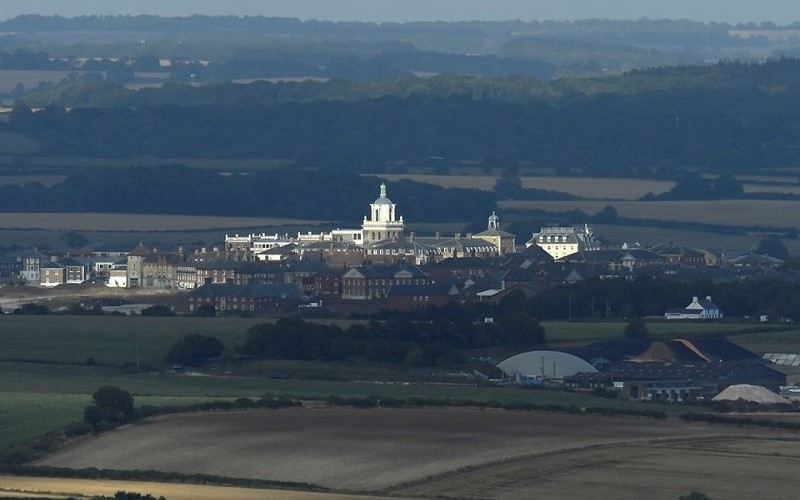Poundbury suburb showcases King Charles’s vision of British life

A general view of the planned community of Poundbury, built on land owned by, and with the design approved by Britain’s Prince Charles, on the outskirts of Dorchester, Britain, August 19, 2022.
11:26 JST, September 15, 2022
POUNDBURY, England (Reuters) – Anyone seeking insights into the values of King Charles, who as prince caused controversy by expressing strong opinions and sometimes seeking to act on them, can head to the quaint urban development of Poundbury, his pet project.
An extension to the town of Dorchester in southwest England, built according to his architectural principles, it illustrates how different his approach to public life has been from that of his mother, Queen Elizabeth, who died a week ago aged 96.
The late queen gave little away about her opinions and preferences, and was careful to avoid controversy. As prince, Charles shared his views on subjects that interest him such as architecture, environmental protection and alternative medicine.
He signaled in his first address as king last week that he would be more reserved from now on, but Poundbury stands as a physical, populated testimonial to his lifelong passions.
The land on which Poundbury is built is part of the Duchy of Cornwall. As Duke of Cornwall before becoming King, Charles owned the land, so when it was designated for the expansion of Dorchester, Charles saw an opportunity to put his ideas about architecture into practice, commissioning architects and developers to realize his vision.
“I was told it was completely uneconomic. So everybody was against it, from the Treasury to everybody else,” Charles told an ITV documentary in 2019.
“In the end, I was determined to stick to my guns. I got on regardless of the endless criticism and carping and shouting and screaming. Because I’ve always believed in the long term.”
Critics say that with its lack of road signs and oddly curved streets, Poundbury is more like a toy town than a real place, betraying an amateurish approach.
But others admire Charles for sticking to his convictions and facing down naysayers over 30 years, to create a community that is popular with its roughly 4,500 residents and attractive to newcomers.
Construction of Poundbury began in 1993, after Prince Charles had set out his ideas in the 1989 picture book “A Vision of Britain: A Personal View of Architecture.”
He expressed his preference for “buildings that have grown out of our architectural tradition and that are in harmony with nature,” deriding post-war architecture and modern urban planning for its “sheer unadulterated ugliness and mediocrity.”
“The ethos of Poundbury is to build a town, a place that works primarily for the people who live here,” Blake Holt, chairman of the Poundbury Residents’ Association, told Reuters.
“So what we have in Poundbury is high quality, creative architecture, which is on a human scale.”
A LOT OF HOUSES
A single road sign, indicating that roundabout rules apply to the area around a statue of Charles’s maternal grandmother, the Queen Mother, is the one concession made to traffic signage.
Along with the wonky roads, the absence of signs is supposed to force drivers to slow down and give way to pedestrians.
The unusual approach to traffic management, along with the variety of building styles that draw on different aspects of Britain’s architectural heritage, contribute to Poundbury’s distinctive look.
Businesses are integrated into the design, with about 2,500 jobs in shops, cafes, offices and factories.
A local chocolate maker is among the development’s success stories. For a time, a cereal manufacturer clogged up the genteel streets with lorries, but it has since moved.
“So we learned from that that there are certain industrial or business uses you can incorporate easily into residential, mixed-use neighborhoods, and some won’t fit,” Simon Conibear, who was estate director at Poundbury for 20 years before retiring, told Reuters.
Despite initial skepticism, locals are warming to Poundbury, said Chris Moyle, 64, from nearby Weymouth, whose mother is considering moving to the development.
“A lot of people first thought it was a bit lacking in character,” he said. “It’s grown a bit, it’s started to have bars and cafes and things open, whereas at first it was just a lot of houses.”
MARMITE EFFECT
“We found it to be a very welcoming place … Most people are relative newcomers so everybody’s very open minded to socialize,” said Judy Tate, an artist who lives in Poundbury.
Rising house prices show Poundbury’s appeal, though critics say it is unaffordable for many people.
The average property price in Poundbury over the last year was over 400,000 pounds ($463,000), according to property website Rightmove.
The Duchy of Cornwall office which manages the development says it meets official targets for social housing.
“There’s always been a bit of a Marmite effect in the town as a whole … Some things have worked absolutely brilliantly, some things not so well,” said local councilor Richard Biggs, referring to a famously divisive yeast spread which people tend to either love or hate.
“There’s always sort of conflict between the design vision of Prince Charles and the architects and what can actually be allowed under highway rules and all these sort of things.”
With Charles becoming king, his son William has succeeded him as Duke of Cornwall and comes into possession of the land. William has not shown the same interest in architecture and planners expect no interference from him as building continues.
Conibear said that despite small modifications to the original plan, “the development has been delivered consistently on the whole with its original principles.”
“I think he (Charles) will always be proud of Poundbury and rightly so,” Conibear said. “(He’ll) consider it ‘job done’, effectively, when Poundbury is finished in 2025.”
$1 = 0.8641 pounds



